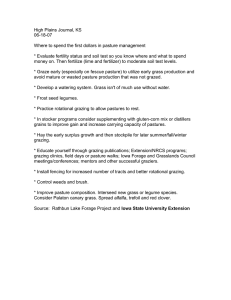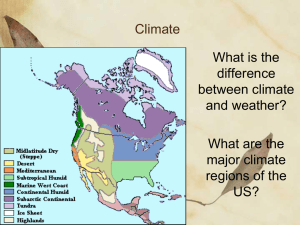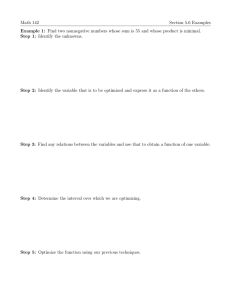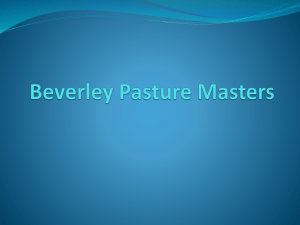Biomass Production and Utilization of Natural Pastures in the Chilean Mediterranean
advertisement
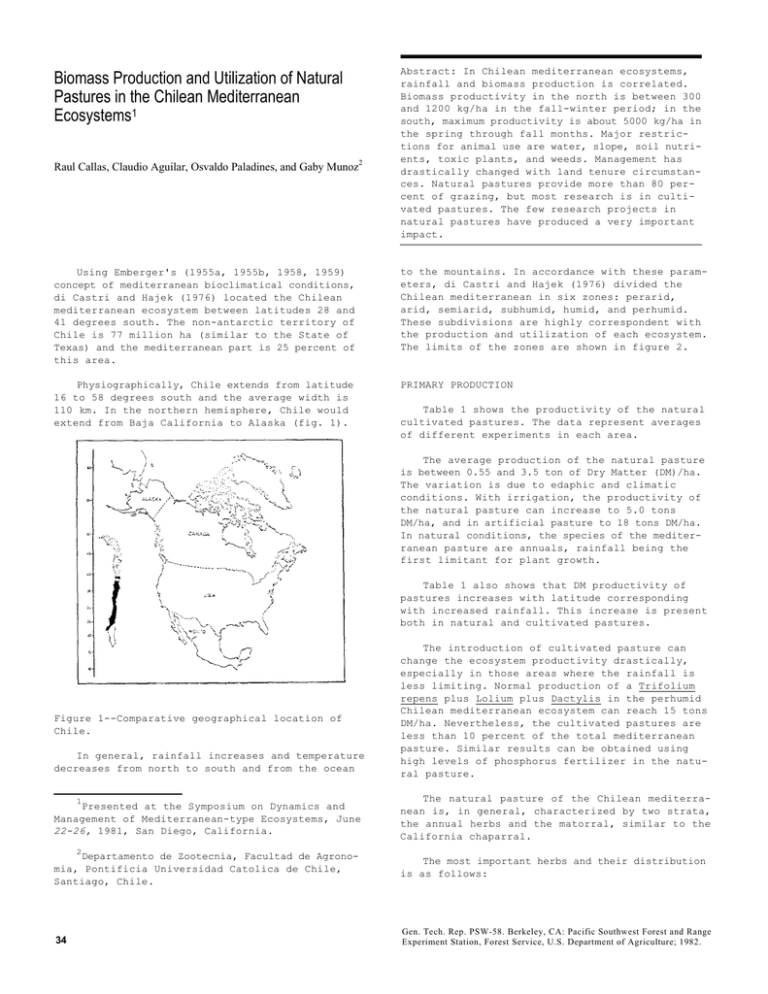
Biomass Production and Utilization of Natural Pastures in the Chilean Mediterranean Ecosystems1 Raul Callas, Claudio Aguilar, Osvaldo Paladines, and Gaby Munoz2 Abstract: In Chilean mediterranean ecosystems, rainfall and biomass production is correlated. Biomass productivity in the north is between 300 and 1200 kg/ha in the fall-winter period; in the south, maximum productivity is about 5000 kg/ha in the spring through fall months. Major restrictions for animal use are water, slope, soil nutrients, toxic plants, and weeds. Management has drastically changed with land tenure circumstances. Natural pastures provide more than 80 percent of grazing, but most research is in cultivated pastures. The few research projects in natural pastures have produced a very important impact. Using Emberger's (1955a, 1955b, 1958, 1959) concept of mediterranean bioclimatical conditions, di Castri and Hajek (1976) located the Chilean mediterranean ecosystem between latitudes 28 and 41 degrees south. The non-antarctic territory of Chile is 77 million ha (similar to the State of Texas) and the mediterranean part is 25 percent of this area. to the mountains. In accordance with these parameters, di Castri and Hajek (1976) divided the Chilean mediterranean in six zones: perarid, arid, semiarid, subhumid, humid, and perhumid. These subdivisions are highly correspondent with the production and utilization of each ecosystem. The limits of the zones are shown in figure 2. Physiographically, Chile extends from latitude 16 to 58 degrees south and the average width is 110 km. In the northern hemisphere, Chile would extend from Baja California to Alaska (fig. 1). PRIMARY PRODUCTION Table 1 shows the productivity of the natural cultivated pastures. The data represent averages of different experiments in each area. The average production of the natural pasture is between 0.55 and 3.5 ton of Dry Matter (DM)/ha. The variation is due to edaphic and climatic conditions. With irrigation, the productivity of the natural pasture can increase to 5.0 tons DM/ha, and in artificial pasture to 18 tons DM/ha. In natural conditions, the species of the mediterranean pasture are annuals, rainfall being the first limitant for plant growth. Table 1 also shows that DM productivity of pastures increases with latitude corresponding with increased rainfall. This increase is present both in natural and cultivated pastures. Figure 1--Comparative geographical location of Chile. In general, rainfall increases and temperature decreases from north to south and from the ocean 1 Presented at the Symposium on Dynamics and Management of Mediterranean-type Ecosystems, June 22-26, 1981, San Diego, California. The introduction of cultivated pasture can change the ecosystem productivity drastically, especially in those areas where the rainfall is less limiting. Normal production of a Trifolium repens plus Lolium plus Dactylis in the perhumid Chilean mediterranean ecosystem can reach 15 tons DM/ha. Nevertheless, the cultivated pastures are less than 10 percent of the total mediterranean pasture. Similar results can be obtained using high levels of phosphorus fertilizer in the natural pasture. The natural pasture of the Chilean mediterranean is, in general, characterized by two strata, the annual herbs and the matorral, similar to the California chaparral. 2 Departamento de Zootecnia, Facultad de Agronomia, Pontificia Universidad Catolica de Chile, Santiago, Chile. The most important herbs and their distribution is as follows: 34 Gen. Tech. Rep. PSW-58. Berkeley, CA: Pacific Southwest Forest and Range Experiment Station, Forest Service, U.S. Department of Agriculture; 1982. Figure 2--Chilean mediterranean ecosystems. (According to di Castri and Hajek 1976) 35 Table 1--Primary productivity of pastures in the Chilean mediterranean at different latitudes Productivity Natural pasture Rainfall Zone Provinces Latitude Cultivated nonirrigated mm/yr ----------------- ton MS/ha/yr Arid Semiarid Semiarid Semiarid Humid Humid Perhumid Perhumid Perhumid Perhumid Coquimbo Aconcagua Valparaiso Santiago Talca Linares Bio-Bio Concepcion Arauco Osorno 32° 30°30' 33º 33°30' 35°25' 35°45' 36°30' 36°50' 37° 40°35' 134.0 380.0 438.4 441.3 712.8 816.6 1,034.2 1,220.2 1,599.1 1,216.9 1.62 2.03 2.10 2.13 2.48 2.56 2.72 1 1.75 2.06 3.38 2 1 Poorly drained soils. 2 Naturalized introduced species. Arid Arid Arid Arid Arid Semiarid Semiarid, Subhumid Semiarid, Subhumid Subhumid Naturalized Erodium cicutarium Bromus mollis Avena barbata Dactylis glomerata Medicago arabica Gnaphalium sp. Hypochoeris radicata Dichondra repens Trifolium angustifolium Trifolium repens Lolium sp. Arid Arid, Semiarid Subhumid Subhumid Subhumid Subhumid Subhumid Subhumid Subhumid Subhumid Subhumid The matorral strata can be divided using criteria from Avila and others (1978) based on topographic gradient, into 1. Sclerophyllous evergreen forest located in the central part of the valley. The most important matorral species are Cryptocarya alba Maytenus boaria Quillaja saponaria 2. 36 Matorral located on mountain slopes, south exposure. The most important species are 0.995 3.58 6.43 5.67 3.15 8.91 -------------13.63 9.19 7.07 - 6.85 Lithraea caustica Schinus polygamus Quillaja saponaria Colliguaya odorifera Kagenckia oblonga Satureja gilliessi Natural herbs Chaetanthera ciliata Solenomelus peduncularis Pectocarya penicillata Pasithea coerula Helenium aromaticum Vulpia dertonensis Plantago mayor Briza minor Hordeum chilense Cultivated irrigated 3. Low matorral located on gentle mountain slopes with north exposure. The most important species are Colliguaya odorifera Colletia spinosa Retanilla ephedra Trevoa trinervis Talaguenea quinquineruvia In the southern part of the Chilean mediterranean ecosystem, there is also sclerophyllous forest with hydrophilic species. The most important species are Nothopagus dombey Drymis winteri Nothopagus obliqua Araucaria araucana ANIMAL PRODUCTIVITY Table 2 presents the population of animals in the Chilean mediterranean. Animal species are distributed according to the prevalent rainfall of the area. Goats are concentrated mainly in the arid and semiarid zones, sheep in the semiarid, and cattle in the perhumid zone (fig. 3). Countrywide, the mediterranean contains 64 percent of the cattle, 32 percent of the sheep, and practically 100 percent of the goats. Figure 3--Animal population in Chilean mediterranean ecosystems. 37 Table 2--Animal population in the Chilean mediterranean 1 Cattle Zone Perarid Arid Semiarid Semiarid Subhumid Humid Humid Humid Perhumid Perhumid Perhumid Perhumid Provinces Antofagasta Atacama-Coquimbo Aconcagua-Valparaiso Santiago O'Higgins-Colchagua Curico-Talca Linares-Maule Nuble Concepcion-Arauco Bio-Bio-Malleco Cautin Osorno TOTAL 1 2 AU 2 Sheep Percent 583.3 52,894.0 107,078.2 109,443.6 144,697.1 108,065.9 76,270.3 116,417.8 83,019.7 285,455.6 350,782.3 271,897.5 0.03 3.09 6.27 6.41 8.43 6.33 4.46 6.82 4.86 16.72 20.55 15.93 1,706,605.3 100.00 AU Percent 2,877.3 19,583.2 25,175.7 5,208.9 39,134.3 24,448.2 13,824.5 19,459.2 4,672.5 20,104.3 33,507.5 10,656.4 218,652.0 Total Goats AU (Percent 1.31 8.95 11.51 2.38 17.89 11.18 6.32 8.89 2.13 9.19 15.32 4.87 623.2 60,621.6 8,827.8 3,044.3 5,956.0 4,794.7 5,138.8 8,936.4 18,873.9 11,537.4 11,880.0 5,323.2 0.42 41.64 6.06 2.09 4.09 3.29 3.53 6.13 12.96 7.92 8.16 3.65 100.00 145,557.3 100.00 AU 4,083.8 133,098.8 141,081.7 117,696.8 189,787.4 137,308.9 95,233.6 144,813.4 106,566.1 317,097.3 396,169.8 287,877.1 2,070,814.6 Extracted from the Nation Agricultural Census, 1975-1976. Animal Unit equivalent to a 500-kg steer. Table 3--Animal productivity of the Chilean mediterranean Pasture area 1 Zone Provinces Perarid Arid Semiarid Semiarid Subhumid humid Humid Humid Perhumid Perhumid Perhumid Perhumid Natural Improved Antofagasta 111,899 Atacama-Coquimbo 1,748,091 Aconcagua-Valparaiso 539,343 Santiago 263,271 O'Higgins-Colchagua 553,141 Curico-Talco 509,891 Linares-Maule 257,540 Nuble 344,599 Concepcion-Arauco 155,334 Bio-Bio-Malleco 729,475 Cautin 460,580 Osorno 178,952 0,000 7,138.4 14,233.6 19,175.2 25,801.8 33,448.2 13,236.0 24,181.4 25,725.8 148,000.9 101,074.6 144,089.4 Cultivated 1,843 10,736 14,024 27,066 43,588 34,851 17,921 30,121 6,578 91,286 98,559 43,850 Animal population Stocking rate Animal weight gain 2 AU/ha kg/ha AU 4,083.8 133,098.8 141,081.7 117,696.8 189,787.4 137,308.8 95,233.6 144,813.4 106,566.1 317,097.3 396,169.8 287,877.1 0.29 0.07 0.24 0.38 0.30 0.23 0.32 0.36 0.56 0.32 0.60 0.78 105 85 62 70 50 90 122 130 160 180 1 Natural = Native and naturalized pastures Improved = Natural pastures subjected to improvement practices without plowing Cultivated = Sown pastures 2 Animal Units equivalent to a 500-kg steer. Table 3 shows the productivity of pastures expressed in animal weight gain. Stocking rate trebles from the arid to the perhumid zones and coincidental with the increase in stocking rate is an increase in animal production. The Chilean management of the mediterranean ecosystem is characterized by the extensive use of the natural pastures as a source of animal feed. These are normally annual pastures, with a very fast growth period, highly dependent on tempera- 38 ture and rainfall for total dry matter production. On the other hand, animal feed intake is dependent on pasture characteristics. In general, the natural mediterranean ecosystems are fragile. They are easily damaged by abuse and are subject to drought. The original vegetation on a large part of these ecosystems has been depleted by a combination of these factors, with a rapid increase of unwanted matorral species and herbs (Fuentes and Hajek 1978, Gasto and Contreras 1979). The major damage to the natural ecosystems is near the water sources and the animal keeper's house, due to higher animal density and the selective consumption by animals of plants and plant parts, producing changes in the botanical composition of the pasture. This selective harvesting pattern promotes the growth of unwanted matorral species and herbs over useful pasture species. Table 6 shows average results. Land price is highly dependent, in the north and central zone, on the water available for irrigation. Thus, a goat farmer in the north part of the Chilean mediterranean ecosystem who has the opportunity to irrigate a portion of the farm prefers to eliminate the animals and grow fruit. Rodriguez (1979) studied the digestibility of the available and animal-selected natural pasture. Pasture availability was estimated by cutting and the diet selected by animals via esophageal fistula. HISTORY OF PASTURE MANAGEMENT Table 4 presents the contrasting digestibility in 5 months of the year as pasture becomes depleted by grazing. Grazing animals select plants or plant parts with a higher content of protein, phosphorus, metabolizable energy, and lower content of fiber. As shown in table 5, animals select different plants depending on maturity (as represented by season of the year) and digestibility. Sheep grazing a winter therophytic pasture select first Erodium sp.; as soon as Erodium sp. availability decreases, the animals select Trisetobromus hirtus and later Vulpia dertonensis. There are some species, such as Hordeum murinum and Koelenia phleoides, that are not eaten by the animals. With a very high stocking rate, the pasture will rapidly increase in these unwanted herbs. LAND SURFACE REQUIRED PER FAMILY The minimum annual wage of farm labor is $2000 (U.S.). Assuming that in a family of five persons there is only one land worker, the total family income will be $2000/year. A study of different farms along the mediterranean ecosystem was conducted in order to estimate the theoretical minimum farm size required for a worker to obtain the family income of $2000. Land price was not included in the calculation of the profit of different agricultural businesses, because it increases independent of the farm business. Table 4--In vitro digestibility of available and animal-selected pasture in the perarid zone of the 1 Chilean mediterranean 2 Season Spring Summer Fall Early winter Late winter Stage of grazing cycle Early Medium Late 56.91 55.42 46.73 53.56 49.39 37.91 53.38 43.65 37.92 49.01 42.04 37.62 51.90 47.60 42.72 1 Taken from Rodriguez 1979. 2 Each grazing cycle lasted for 20 days. The use of the mediterranean ecosystem has drastically changed with land tenure patterns. Before the Agrarian Reform (1965-73) large land holdings complemented their pasture utilization system by the movement of stock between ecosystems at different times of the year. Two such systems prevailed. In one, animals were raised in the humid and perhumid zones and moved to the semiarid ecosystem to be finished. This was possible, as depicted in figure 4, because the humid mediterranean ecosystem produces its maximal amount of digestible energy during spring and summer. Winter is cold and humid. The arid and semiarid ecosystems produce their maximum of digestible energy during fall and winter. Winter is not very cold but is humid. On the other hand, beef prices are minimum during fall and maximum during spring. Having these in mind, farmers raised their animals in the arid, semiarid, or irrigated pastures of the central zone, during fall, to be fed in good pasture during 150 days and sold with 530 kg of weight in the season of maximum price. The second system corresponds to the "transumancia," by which the animals were sent to the high mountains during summer and returned to the lowlands for fall and winter. As shown in figure 5, peak DM production at the two altitudes complement each other very well. This system was employed principally in the Central Provinces of the country and especially applied to sheep production. These two types of animal management systems produced long periods when pastures had very low or no stocking, giving a rest period to the pasture and in general more stability. With Agrarian Reform, and the resulting subdivision of land holdings, farms were limited to a circumscribed small area and movement of animals was inhibited. Several situations were produced. In the humid and perhumid zones, farms decreased in size but maintained essentially the same production systems. In the semiarid and arid zones, drastic changes were produced, since by virtue of the smaller size, farms could not count on a highland-lowland combination. Farms in lowlands with irrigation turned to fruit production or other high-profit crop. Those on nonirrigated lands tended to maintain the original stocking rate, overgrazing their pastures because they did not have the complement of irrigated area for winter feeding. 39 Table 5--Botanical composition of a perarid-zone pasture of the 1 Chilean mediterranean grazed with sheep Stage of grazing cycle Early Season 2 Medium Late Species ------------ -- ----Percent---- - ----------- Spring Vulpia dertonensis Trisetobromus hirtus Erodium sp. Hordeum murinum Koelenia phleoides Compositae and legumes Others 39.83 23.58 17.25 1.75 1.96 10.72 4.91 60.29 15.40 13.60 2.53 2.41 4.33 1.44 46.61 17.65 12.67 3.17 19.91 Summer Vulpia dertonensis Trisetobromus hirtus Erodium sp. Koelenia phleoides Compositae and legumes Proustia cuneifolia Others 39.00 28.41 19.21 1.66 1.24 7.31 3.17 71.19 10.90 8.96 1.45 7.5 53.01 14.46 4.82 3.61 4.10 Fall Vulpia dertonensis Trisetobromus hirtus Erodium sp. Hordeum murinum Koelenia phleoides Compositae and legumes Others 60.42 13.36 14.17 1.30 1.95 3.91 4.89 62.93 17.33 7.47 4.00 8.27 66.09 9.78 3.43 20.70 Early winter Vulpia dertonensis Trisetobromus hirtus Erodium sp. Compositae and legumes Others 65.10 19.46 9.40 2.01 4.03 73.18 19.55 5.18 2.09 18.09 14.89 67.02 Late winter Vulpia dertonensis Trisetobromus hirtus Erodium sp. Others 63.27 19.47 13.72 3.54 46.27 10.45 26.87 16.42 48.78 17.07 34.15 1 Taken from Rodriguez 1979. 2 Each grazing cycle lasted for 20 days. Table 6--Economic parameters of different agricultural business and theoretical land area necessary to obtain an income equivalent to the minimum farm wage Zone and type Land price Principal use of the ecosystem U.S.$/ha North, natural pastures North, with irrigation Central, natural pasture Central, with irrigation South 40 300 2000 450 3500 2300 Goats Fruit Sheep, beef Fruit Milk, beef Average return to capital Surface required per family Percent ha 6 25 10 20 10 102.7 3.7 41.0 2.64 8.04 There is an intermediate point which combines the utilization of natural and cultivated pastures to take advantage of the difference in seasonal growth pattern of the two types of pasture. One of the most important conclusions of pasture research is that with a rainfall of less than 500, fertilizer effect is very low and nonprofitable. Also, with less than 500 mm, seeding of cultivated pasture is risky. With more than 900 mm of rainfall, the seeding of cultivated pasture and the incorporation of fertilizer is highly recommended, producing an increase in animal production and profit. LITERATURE CITED Figure 4--Pasture production of humid and semiarid mediterranean ecosystems, and its effect on beef price. Figure 5--Pasture production in two complementary arid mediterranean ecosystems. PASTURE RESEARCH IN THE MEDITERRANEAN ECOSYSTEMS According to Paladines (1980) 85 percent of the Chilean pastures are natural, yet a very low percentage of the total pasture research has been designed to study some productive or management characteristic of the natural pastures. Two schools of thought have developed in Chile in relation to the emphasis of pasture research. One school thinks that as natural pastures are such a large area, even if the unit value is not high, any small improvement can produce large changes at the country level. The other school thinks that the potential of natural pastures is so little that research priority must be placed on the introduction of exotic species, or even better, on the use of irrigation water. Avila, G.; and others. 1978. Estudio morfologico en raices de algunos arbustos del matorral chileno. Medio Ambiente 3(2):31-39. Castri, F. di; Hajek, E. R. 1976. Bioclimatology of Chile. Vicerrectoria Academica. Universidad Catolica de Chile. Emberger, L. 1955a. Project d'une classification biographique des climats. Ann. Biol. 31(5-6): 249-255. Emberger, L. 1955b. Une classification biogeographique des climats. Recueil des travaux des laboratoires de Botanique. Geologie et Zoologie (Faculte des Sciences, Montpellier), Serie Botanique, Fasc. 7:3-43. Emberger, L. 1958. Afrique du nord et Australie mediterraneene. En: Climatology and microclimatology. Proceedings of the Canberra Symposium. UNESCO, Paris: 141-147. Emberger, L. 1959. La place de 1'Australie mediterraneenne dans 1'ensemble des pays mediterraneens du Vieux Monde. (Remarques sur le climat mediterraneen de l'Australie) Biogeography and Ecology in Australia (Monographiae Biologicae) 8:259-273. Fuentes, E. R.; Hajek, E. R. 1978. Introduccion hombre-clima en la desertificacion del Norte Chico Chileno. Ciencia e Investigacion Agraria. 5:137-142. Gasto, J.; Contreras, D. 1979. Un caso de desertificacion en el norte de Chile, El ecosistema y su fitocenosis. Boletin Tecnico M:42. Universidad de Chile, Facultad de Agronomia. 99 p. Paladines, M. O. 1980. Investigacion sobre praderas en Chile. Convenio ODEPA-Pontif, Universidad Catolica de Chile. Rodriguez, S. D. 1979. Influencia del momento de utilizacion de la pradera natural de la zona mediterranea central de Chile en el consumo ovino. Tesis de grado de magister Programa Permanente para Graduados en Ciencias Agropecuarias y Forestales de la Rep. de Chile. Universidad de Chile. 41

